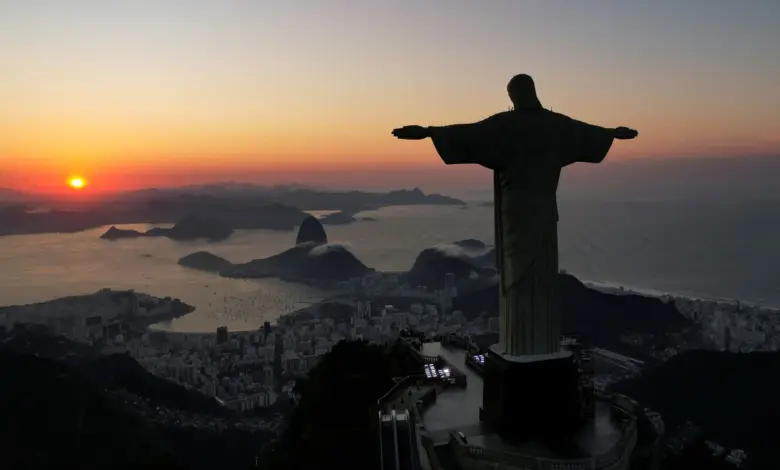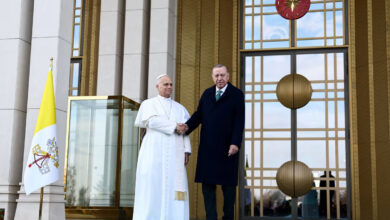
Perched high atop Corcovado Mountain, Christ the Redeemer is more than a religious symbol or tourist attraction — it’s an enduring icon of Brazilian identity. The Cristo Redentor, as Brazilians call it, is a postcard not only for the city of Rio de Janeiro but for the entire country.
The statue’s wide-open arms, spanning 92 feet, seem to personally welcome the more than 4 million visitors who make the trek to see the monument each year. But now, its management and future are at the center of a growing debate over religion, conservation, and governance.
In October, a bill was introduced proposing transferring the management of the land where the statue sits from federal oversight to the Catholic Church. Proponents argue that the church’s stewardship will resolve longstanding infrastructure and accessibility issues. Critics, however, see the move as a threat to Brazil’s secular state and its environmental commitments.
A monument in the forest
Built in 1922 by the Catholic Church, the Christ the Redeemer statue is inside the Tijuca National Park, a sprawling 3,953-hectare expanse of restored Atlantic Forest recognized as one of the world’s first large-scale reforestation projects in 1861, more than a decade before Yellowstone’s founding.
Replanted to mitigate the effects of deforestation caused by coffee plantations, Brazil’s then-emperor established the national park to preserve ecologically significant ecosystems and provide a sanctuary for biodiversity. It was declared a UNESCO World Heritage site in 2012, and today is home to 1,619 plant species and 328 animal species, many of which are endangered.
“This park is far more than just a backdrop to the Redeemer,” says Mauro Pires, president of Brazil’s national parks and conservation units agency, ICMBio. “It’s a vital ecological system that sustains local wildlife and plays a role in regulating Rio’s climate and water supply.”
The park’s attractions include panoramic viewpoints of the city, Guanabara Bay, and the Atlantic Ocean, cascading waterfalls, and historic ruins. It is a magnet for tourists and locals alike, who come to hike, cycle, or take guided tours to drink up Rio’s natural beauty.
However, the balance between tourism and conservation is delicate, particularly in high-traffic areas like Corcovado.
An agreement between Church and State
The bill proposes carving out the Christ and surrounding area from the Tijuca National Park, making it a separate and independent portion to be administered by the Archdiocese of Rio de Janeiro. The Church being solely responsible for this area, it would have to take on any needed renovations, but it could also start collecting the revenue from ticket sales.
The current arrangement splits responsibilities between the church and the federal government. Despite being on federal land, the archdiocese has special authorization to worship at the statue and adjoining chapel any time, and is responsible for their maintenance, though not the infrastructure around it.
The federal government oversees the entirety of the park and its infrastructure – including roads, transportation, bathrooms, escalators, and ticketing to the statue. A portion of ticket sales and concessions is paid to the Church, and according to a park spokesperson, and in 2023 it amounted to $1.78 million.
Until now, the site has functioned as a religious destination within a secular site. Masses, baptisms, and weddings can be celebrated at the foot of the Christ, as long as the general public still have access to the park during visiting hours.

The Church and proponents of the bill, on the other hand, say more should be done to capitalize on the monument’s fame. “If a Brazilian brand wants to adopt our bathroom and renovate it and put their name all over it, why shouldn’t they be able to do it?” asked Claudine Milione Dutra, legal coordinator for the Archdiocese of Rio de Janeiro.
Dutra argues that federal bureaucracy is also getting in the way of addressing some of the needs for which the park is currently responsible. At the introduction of the bill in October, lawmakers described escalators, bathrooms, and water fountains that were out of order for months at a time.
“We cannot accept that Christ the Redeemer, Brazil’s most recognizable international icon, remains in a state of neglect,” said Senator Carlos Portinho, author of the bill, when he introduced it in the senate chambers. “The church has historically cared for the statue and is best positioned to manage it effectively.”
Pires, the president of the national parks agency, acknowledged that repairs are needed but said that privatization is not the answer. Under the administration of former President Jair Bolsonaro, national parks budgets were slashed and only now are funds coming back, Pires said. Many of the necessary renovations, at Tijuca and other national parks, could not be carried out for that simple reason.
But for 2025, the agency has earmarked $12 million to carry out renovations at the top of Corcovado Mountain – including repairs to the foundation of the statue.
‘A dangerous precedent’
Under the proposed legislation, the Church would gain control over the statue and its immediate surrounding area, along with its infrastructure, and become separate from the National Park. Though that area would be less than 0.02% of the park’s total area, the national parks agency warns that the proposal could set a dangerous precedent.
“This isn’t just about the Redeemer; it’s about the integrity of all conservation areas in Brazil,” Pires explained. “Carving out sections of national parks for private management could undermine decades of progress in environmental protection.”
The park’s fragile ecosystem includes species such as the tufted capuchin monkey and the coati, a Brazilian ringtail. Tapirs and jaguars used to roam the park as well, but have since been extinct from the park. Increased noise, pollution, and construction could disrupt these habitats.

But Dutra dismisses these concerns, asserting that the church shares an interest in conservation. “We’ve maintained the statue and its immediate surroundings responsibly. Our aim is to enhance the visitor experience, not to harm the environment,” she said.
At its core, the debate isn’t just about land use or conservation. Brazil’s secular constitution prohibits government favoritism toward religious institutions, but Christ the Redeemer is pushing the discussion to a decidedly gray area, raising questions about how Brazil can balance its Catholic roots with its secular and environmental commitments.
The bill — co-sponsored by Senator Flavio Bolsonaro, the former president’s son — has already passed in the Senate and is being weighed by a subcommittee on tourism. If approved there, it will move to Brazil’s House of Representatives.
The bill has already passed in the Senate and is being weighed by a subcommittee on tourism. If approved there, it will move to Brazil’s House of Representatives, who will decide if Christ the Redeemer’s future lies with the church or the state—or some reimagined collaboration.




